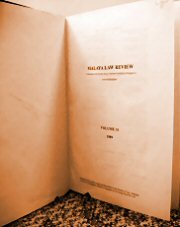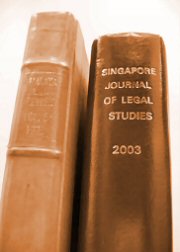| 391. | JULY 2010 Issue | p.107 |
|
|
| The Law in Singapore on Rights and Responsibilities in Marital Agreements
Leong Wai Kum • [2010] Sing JLS 107 (Jul)People, including the soon-to-be married and the already married, have the right to enter agreements with each other. Where spouses are content with the terms they negotiated, there is no reason for family law to intervene. At the same time spouses owe one another responsibilities, some of which crystallise only upon their divorce. The law in Singapore balances the interests that arise from both facets of the marital relationship. The law upholds the legality of marital agreements unless they make a mockery of the marital relationship but subjects all of them to the scrutiny of the court, which retains power to make fair financial orders between spouses upon divorce and protect their children. This paper traces current law in Singapore and compares it with law that allows an agreement to displace the court's power.
|
| 392. | JULY 2010 Issue | p.129 |
|
|
| Reading Suitability Against Fitness for Purpose-The Evolution of a Rule
Gail Pearson • [2010] Sing JLS 129 (Jul)For some time, and more urgently since the global financial crisis, there has been an interest in suitability as a method for protecting consumers. In broad terms, suitability means that consumers should receive the thing which best suits or fits their requirements or purposes. In the context of making loans to consumers, this means that consumer credit products should be suitable to the circumstances and requirements of the borrower. Suppliers in the market for goods have long been required to provide goods that are fit for the purpose of the buyer. Nevertheless, the idea that credit providers must supply loans that are not unsuitable is seen as startlingly new. This article examines the long and international history of the statutory obligation of fitness for purpose. It argues that this history shows that the objectives of the implied term are not dissimilar to the objectives for responsible lending and now, the imposition of a suitability requirement. In this way, the article explores a convergence between what is required of product providers in the market for goods and services and those in the market for financial services, with a particular examination of the Australian model in the National Consumer Credit Protection Act 2009 (Cth).
|
| 393. | JULY 2010 Issue | p.151 |
|
|
| The Fame Monster Reloaded: The Contemporary Celebrity, Cultural Studies and Passing Off
David Tan • [2010] Sing JLS 151 (Jul)The common law jurisdictions of Australia and Singapore often adopt a conservative approach to recognising newproperty rights, particularly with respect to the human persona, but courts frequently take their cue from developments in the United Kingdom. This article revisits the landmark cases in these jurisdictions which, in declaring that a property right in the goodwill of a celebrity may be protected against unlicensed commercial appropriation, use language evocative of the right of publicity. It examines howthe courts have expanded the passing off action to prevent the unauthorised commercial use of the images of well-known personalities. Finally, by adopting a cultural studies analysis that investigates the semiotic nature of the celebrity sign and its influence on contemporary consumption, this article offers a different perspective to the debate on the protection of image rights.
|
| 394. | JULY 2010 Issue | p.177 |
|
|
| Legislation Comment and Case Note: English Reform of Provocation and Diminished Responsibility: Whither Singapore?
Stanley Yeo • [2010] Sing JLS 177 (Jul)
|
| 395. | JULY 2010 Issue | p.192 |
|
|
| Legislation Comment and Case Note: A New Era of Employer Liability in Negligence: Chandran a/l Subbiah v. Dockers Marine Pte. Ltd.
Margaret Fordham • [2010] Sing JLS 192 (Jul)
|
| 396. | JULY 2010 Issue | p.202 |
|
|
| Legislation Comment and Case Note: Differentiating Between Brand and Trade Mark: City Chain v. Louis Vuitton Malletier
David Tan • [2010] Sing JLS 202 (Jul)
|
| 397. | JULY 2010 Issue | p.211 |
|
|
| Book Review: Administrative Law and Governance in Asia: Comparative Perspectives by Tom Ginsburg and Albert H.Y. Chen, eds.
Arun K. Thiruvengadam • [2010] Sing JLS 211 (Jul)
|
| 398. | JULY 2010 Issue | p.222 |
|
|
| Book Review: Tan Sook Yee's Principles of Singapore Land Law by Tang HangWu and Kelvin F.K. Low, eds.
Wu Zhuang-Hui • [2010] Sing JLS 222 (Jul)
|
| 399. | DECEMBER 2009 Issue | p.301 |
|
|
| Construction of Commercial Contracts and Parol Evidence
Tan Yock Lin • [2009] Sing JLS 301 (Dec)This article argues that theories of interpretation and pragmatics offer solid proof that the rule-based model of construction is flawed and that the judicial shift to commercial interpretation is correct. One insight gained by analysing in the light of these theories what the courts in fact do when they construe commercial contracts is the impossibility of limiting the context to any given set of data, since the contextual-dependence of sentences is both the generator and resolver of any set of interpretative hypotheses. Other valuable insights are that a principle of rationality is necessarily presupposed in any institutionalised interactive goal-oriented communication and that the principle of instrumental rationality necessarily presupposed in the making of a contract is that the assignment of meaning shall accord with the commercial purposes of the contract.
|
| 400. | DECEMBER 2009 Issue | p.332 |
|
|
| Enforcing Corporate Disclosure
Hans Tjio • [2009] Sing JLS 332 (Dec)This article suggests that the gist of securities market disclosure is the furtherance of corporate governance and not investor protection. It will be argued that public enforcement of continuous disclosure rules remains the primary means of enforcement in Singapore. But this should be supplemented by private enforcement. While jurisdictions like the U.K. have introduced legislation loosely mirroring 10b-5 actions in the U.S., allowing investors to seek compensation largely from issuers (and their insurers), recent literature suggests this is a suboptimal solution, given that any damages are ultimately borne by existing shareholders. Courts also face difficulties in conceptualising or quantifying shareholder losses since these are derived from information concerning the assets and prospects of the underlying company. But Singapore courts have shown that it is possible to treat corporate misstatements as a form of fraud against the entity, where generous causation and remoteness rules are available to measure the damages suffered by the corporation.
[Full Text]
|
|







